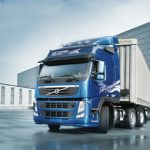Green with … hope?

The 2012 RFA Conference touched on some serious issues facing the transport industry, from carbon tax to “The Road to Mangaung”. But as economist Mike Schüssler proved, it’s the small things that can make the big difference. JACO DE KLERK reports.
It was Monday, May 21, the first day of the Road Freight Association (RFA) Conference – which took place at the Zimbali Coastal Resort in KwaZulu-Natal, with the full convention running from May 20 to 22 – and one little gem called the “Green Wave Project” unexpectedly stood out.
As Schüssler explained: “This isn’t the green wave you think of in terms of a green environment – it’s the synchronisation of robots, to start off with.”
While this idea has been around for a while, since the 1940s, Schüssler highlighted that it has more benefits than one would expect.
According to the World Bank, the simple synchronisation of traffic lights can result in a 10 percent difference in terms of costs and productivity. “It saves you 10 percent of time, 10 percent of money in terms of fuel costs, 10 percent on maintenance, and it saves on carbon gases as well,” said Schüssler.
“Johannesburg just isn’t used to it, because our robots don’t work,” he added with a mischievous smile. “But if you can get the robots to work, and synchronise things, you can save a heck of a lot of carbon, a heck of a lot of fuel and a heck of a lot of time – thus lowering the cost of doing business in South Africa by lowering the logistics costs.”
Schüssler emphasised that this is a project that wouldn’t have to be paid for, since its implementation would involve nothing more than the recalibration of robots. “It would just take a lobbying effort where we say to government ‘Wait a minute – if you are going to tax us on carbon, give us the Green Wave’,” he said.
The technology has a rich history, and additional developments were made to enhance it. “In the 1960s and 70s, they started using algorithms,” said Schüssler.
Apparently the use of algorithms generated another 10 percent of savings, and again, this is something that isn’t difficult to implement. It can even be bought off the shelf. “Remember this is a 10 percent saving on what was now 90 percent of the original,” said Schüssler. In short, you now achieved an improvement of 19 percent.
The Green Wave Project can also be improved with the addition of a third step using various technologies. These include cameras and live information feedback that takes variants such as rush hour traffic into account, and adjusts the robots accordingly. Another enhancement is where road users are informed (through electronic signs or by other means) of the speed they must travel to catch the Green Wave.
“Not many cities are there yet,” said Schüssler, “but in places like Dresden in Germany, where they manage all these systems together, commercial vehicles saved 39 percent of all costs, with 56 percent of savings for trams and buses.”
“I’m not saying this is a true reflection,” said Schüssler. “I’m just giving you what people are saying is now possible. However, imagine you can save this on cost and in time travelled in cities – how many more deliveries will you be able to make, and how much less carbon will you be able to use? That is where the economy comes in.”
He emphasised the simplicity of implementing some of these practices and estimated that South Africa could save at least 15 percent – although 25 percent would be a nice average.
“We need to channel our efforts in a positive way and lobby for this, which isn’t what I normally do,” said Schüssler in his mischievous way. “I’m usually very negative.”
Published by
Focus on Transport
focusmagsa



